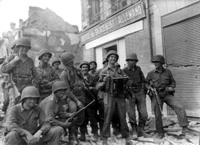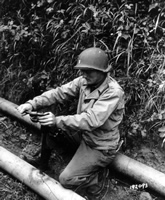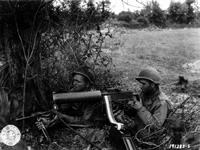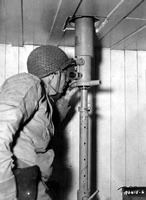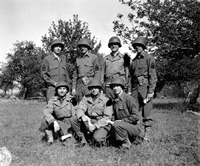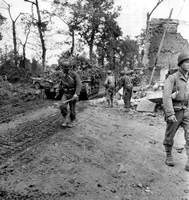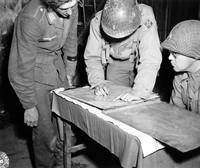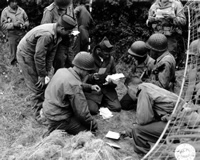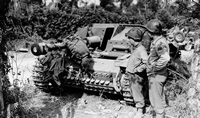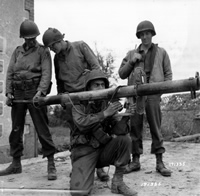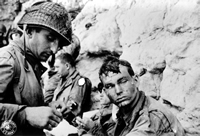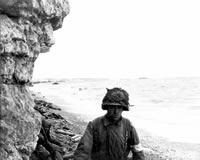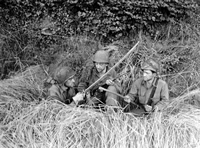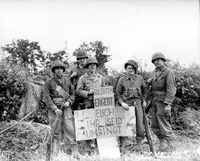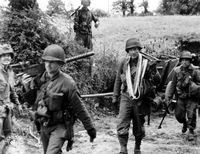The M1 Helmet in Normandy: A Case Study
Date Written: Winter 2009
Author: Chris Guska - 90th IDPG
Research Assistance: Charles McFarlane - 90th LHG, www.90thlhg.tk
From over 2500 photos from the Normandie Archive, we have selected 90 photos where M1 Helmets were visible in a cross-section of the troops and situations in the Normandy campaign.
Source Photographs used in the Study
Not all of the photos are of front line combat troops but rather a representative sample across all branches and roles. I selected several data points of key interest to reenactors to capture.
1.) Helmet Chinstrap Position
2.) Helmet Net Usage
3.) Liner Chinstrap Position
4.) “Hawley” type Fibre Liners
5.) Scrim & Foliage
Here's the breakdown:
Number of Photos: 90
Number of M1 Helmets Observed: 247
1.) Helmet Chinstrap Position:
There were a number of positions that the web chinstrap for the steel helmet was observed to be in:
1.) Up, and affixed across the back (nape) of the helmet.
• 119 Observed of 247 Total
• 48.18% of Total2.) Dangling down at the sides of the helmet
• 15 Observed of 247 Total
• 6.07% of Total
3.) Fastened underneath the chin as designed
• 15 Observed of 247 Total
• 6.07% of Total
4.) Up, attached / woven into a helmet net
• 14 Observed of 247 Total
• 5.67% of Total
5.) Placed in the back (nape) of the helmet, between the shell and liner
• 5 Observed of 247 Total
• 2.02% of Total
6.) Entirely missing, torn or cut off
• 3 Observed of 247 Total
• 1.21% of Total
7.) Chinstraps not visible or not identifiable
• 64 of 247 Total
• 25.91% of Total
2.) Helmet Net Usage:
There were 3 types of helmet nets observed
1.) Small, ¼” netting
• 64 Observed of 247 Total
• 25.91% of Total
2.) Medium, ¾” netting
• 94 Observed of 247 Total
• 38.06% of Total
3.) Large, 2” netting
• 7Observed of 247 Total
• 2.83% of Total
4.) No helmet net
• 82 of 247 Total
• 33.20% of Total
3.) Liner Chinstrap Position:
There were 3 positions that the Helmet Liner Chinstraps were observed to be in
5.) Worn over the brim
• 71 Observed of 247 Total
• 28.74% of Total
6.) Worn under the brim
• 29 Observed of 247 Total
• 11.74% of Total
7.) Worn under the chin as a chinstrap
• 1 Observed of 247 Total
• 0.40% of Total
8.) Not visible for observation
• 145 of 247 Total
• 58.7% of Total
4.) “Hawley” type Fibre Liners:
By the time that production of Pressed Fibre Liners ceased by General Fibre and Hawley in November 1942, over 4 Million Fibre Liners had been produced. Undoubtedly some Hawley liners made it overseas with the troops fighting in Normandy. The question that remains is, how many were used and in what ratio to the later High Pressure type liners.
The Hawley type liner is distinctive from the later High Pressure resin coated liners in that it has a very distinct wide rolled rim that is evident even at a distance. The distinctive rim has allowed me to identify a number of the helmets in the photos to have Hawley type liners.
Of the 247 Total Helmets observed, not limited to only the helmets where the liner was observable the numbers and percentages were as follows:
• 11 of 247 total helmets were observed to have a “Hawley”
• 4.45 % of the total
Hawley Type Liners were observed in the following photos:
2 5 14 28 38 43 45 57 76 81
5.) Scrim & Foliage:
With the high proportion of helmet nets in use some troops exhibit camouflage / disruptive scrim or foliage in their helmet net. Although the photos in the set are not directly focused on combat troops, it is somewhat illustrative to have some examples where soldiers are wearing disruptive or camouflage scrim in their helmets or foliage.
The numbers and percentages were as follows:
• 22 of the 247 total helmets were observed to have camouflage scrim or foliage
• 8.9% of the total
Camouflage scrim or foliage was observed in the following photos:
2 11 14 20 23 30 32 41 42 54 55 60 64 78 82
90th IDPG Original Research



